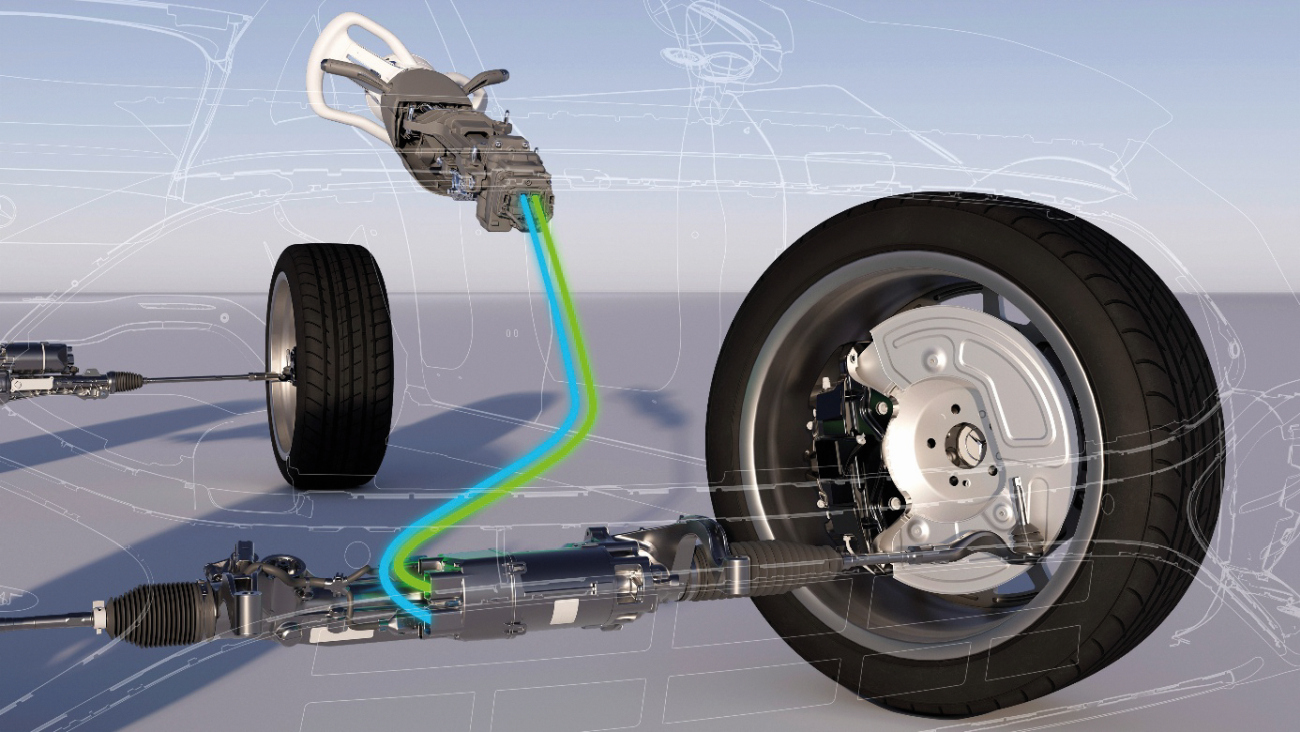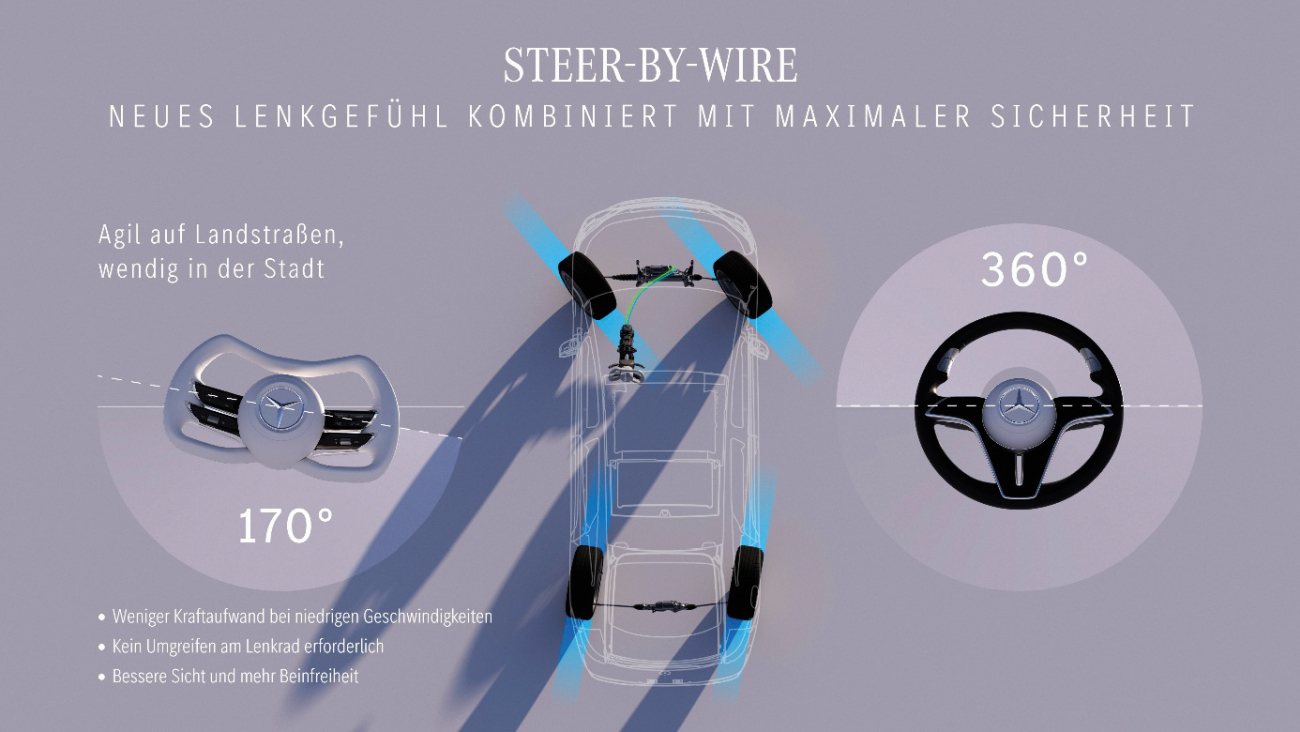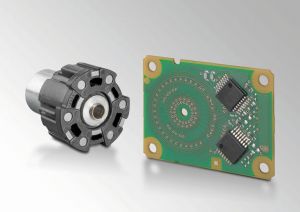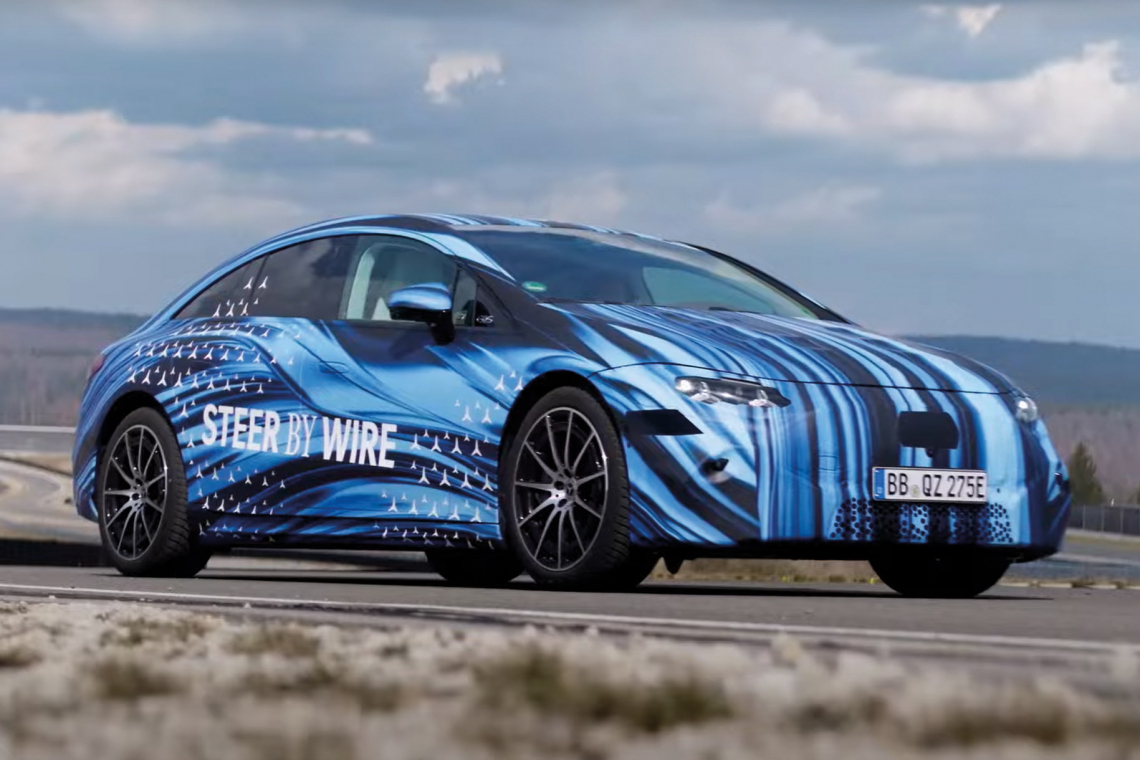Mercedes and NIO/China are at the start and ZF Friedrichshafen is involved as a supplier. Steer-by-wire is the steering system of the future, as the technology is a basic requirement for autonomous driving. This creates a new market segment for printed circuit boards and electronic systems.
February 22, 1987 was a milestone in aircraft technology. The 'fly-by-wire' system went into series production with the first flight of the Airbus A320. Even then, triple redundancy of cables and systems ensured a high level of safety.
Around 40 years passed in the automotive industry before 'steer-by-wire' (SbW) went into series production. The author of this column already reported on the development of steer-by-wire for future cars in PLUS 8/2018.
 Fig. 2: Redundant connections between the innovative yoke steering wheel, sensors and actuators as well as control units for maximum safety
Fig. 2: Redundant connections between the innovative yoke steering wheel, sensors and actuators as well as control units for maximum safety
In contrast to conventional steering, where there is a mechanical connection through the steering linkage and gearbox, SbW uses electronic sensors, actuators and control units. The steering wheel transmits electrical signals to the control unit, which then moves the wheel steering.
Advantages include
- Reduction of steering wheel weight (steering force) and circumference, now Yoke Design
- Improved interior design of the vehicle
- Increased flexibility in the vehicle architecture
- Integration into autonomous driving systems
How steer-by-wire works in detail: Depending on the driving speed and driving situation, an actuator on the steering wheel (steering feedback unit; SFU) transmits the driver's steering signal to the steering rack unit (SRU), which steers the wheels. The SFU also generates the typical steering feel. The mechanical decoupling of the steering wheel and wheels means that there is no direct counterforce. Instead, the tire-road contact is calculated based on the model using the restoring forces of the steered wheels and generated synthetically accordingly.
Key companies in the automotive steer-by-wire systems market include:
- Nissan Motor Company (Japan)
- ZF Friedrichshafen (Germany)
- JTEKT Corporation (Japan)
- Thyssenkrupp (Germany)
- Paravan (Germany)
- Nexteer Automotive (USA)
- Danfoss Power Solutions (USA)
- SKF (Sweden)
- LORD (USA)
- Eaton (Ireland)
 Fig. 3: Selectable steering feel, steering force (steering weight) and directness, reduced steering movement thanks to innovative yoke steering wheel on the left
Fig. 3: Selectable steering feel, steering force (steering weight) and directness, reduced steering movement thanks to innovative yoke steering wheel on the left
NIO ET9 equipped with steer-by-wire system from ZF
As a central component of the 'SkyRide' chassis from NIO, China, the steer-by-wire system was developed in close cooperation with the German technology group ZF. Cooperation with European suppliers is an important part of NIO's EU strategy.
The system offers a fully digital steering system that can be continuously expanded with autonomous driving functions and over-the-air updates. This makes the NIO ET9 one of the first production vehicles in the world with steer-by-wire and sets a new standard for the next generation of electric vehicles.
It also has the 'smartest chassis' in the world. In technical terms, this involves four hydraulic actuators that are integrated into the shock absorbers and can compensate for over 20 cm of suspension travel within a few ms using 48 V technology.
They therefore recalculate the trim position 1000 times per second and compensate for unevenness. This is said to work 60 times faster than conventional air suspension.
NIO uses an Advanced Intelligent Dynamic Control System (AIDC) here.
The digital architecture transforms the NIO ET9 into a Vehicle Motion Control (VMC) system via its Chassis Domain Controller (ICC). This enables precise movements in all directions - forwards, sideways and even vertically. With advanced vehicle dynamics models, the ET9 adapts its performance to driving conditions in real time, resulting in improved handling, greater stability and a more dynamic driving experience.
By integrating the Vehicle Motion Control System, the Advanced Intelligent Dynamic Control System manages the following systems, including
- Steer-by-Wire (SbW) for precise and responsive steering
- Rear-wheel steering (RWS) to improve maneuverability
- Fully Active Suspension (FAS) for a smoother ride
- Brake Control Unit (BCU) for smarter, more efficient braking
- Intelligent torque distribution of the electric drive for optimized power transmission
The NIO ET9 was officially launched as part of NIO Day 2024. A First Edition limited to 999 units was initially on sale in China, and the NIO ET9 will also be available in Europe at a later date. Like the other six vehicle models, it was designed at the Global Design Center in Munich.
The NIO ET9 is still in the preparation phase for its market launch and is not yet available in Germany or Europe.
 Fig. 4: Nio ET9 with steer-by-wire system from ZF and yoke steering wheel
Fig. 4: Nio ET9 with steer-by-wire system from ZF and yoke steering wheel
A look back at 2018
 Fig. 5: HELLA steering angle sensor Torque and Angle Sensor of CIPOS technology (Contactless Inductive Position Sensor)HELLA is already showing the latest generation of the well-known steering angle sensors (TAS, Torque and Angle Sensor) in 2018. The sensors are based on CIPOS (Contactless Inductive Position Sensor) technology and precisely measure the angle and speed at which the steering wheel changes position. This makes them an important building block on the road to autonomous driving. The data is already being used by lane departure warning systems, which can keep the car in lane semi-autonomously with automatic steering impulses. They also ensure the redundancy required for more complex autonomous driving functions.
Fig. 5: HELLA steering angle sensor Torque and Angle Sensor of CIPOS technology (Contactless Inductive Position Sensor)HELLA is already showing the latest generation of the well-known steering angle sensors (TAS, Torque and Angle Sensor) in 2018. The sensors are based on CIPOS (Contactless Inductive Position Sensor) technology and precisely measure the angle and speed at which the steering wheel changes position. This makes them an important building block on the road to autonomous driving. The data is already being used by lane departure warning systems, which can keep the car in lane semi-autonomously with automatic steering impulses. They also ensure the redundancy required for more complex autonomous driving functions.
In a nutshell
- Mercedes goes into series production with the EQS with steer-by-wire in 2026
- NIO is attacking the luxury class with the ET9 and has already launched a pre-series of 999 units in China in 2024, in which the steer-by-wire system from ZF Friedrichshafen is installed
- Several functions are linked with a digital vehicle architecture: steer-by-wire, rear-wheel steering, electronic suspension system, brake-by-wire and torque distribution
- Because steer-by-wire requires less than one turn of the steering wheel, the yoke steering wheel not only saves a significant amount of space, but also increases steering comfort
The good news is that ZF, one of the major German suppliers, is also on the ball in China. Let's hope that the German mass manufacturers will also become marketable on a par with their Chinese competitors in this technology change.
Let's hope that the delicate seedlings of a positive economic turnaround (Purchasing Manager Index PMI) continue to grow and take root.
Stay with us
Yours
Hans-Joachim Friedrichkeit





